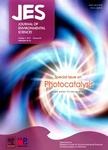Construction of a dual fluorescence whole-cell biosensor to detect N-acyl homoserine lactones
Construction of a dual fluorescence whole-cell biosensor to detect N-acyl homoserine lactones作者机构:Research Center for Eco-Environmental Sciences Chinese Academy of Sciences
出 版 物:《Journal of Environmental Sciences》 (环境科学学报(英文版))
年 卷 期:2014年第26卷第2期
页 面:415-422页
核心收录:
学科分类:0830[工学-环境科学与工程(可授工学、理学、农学学位)] 09[农学] 0903[农学-农业资源与环境]
基 金:supported by the National Natural Science Foundation of China (No. 2117145)
主 题:whole cell biosensor quorum sensing dual fluorescence gfp mcherry indicator
摘 要:Detection of N-acyl homoserine lactones (AHLs) is useful for understanding quorum sensing (QS) behaviors, including biofilm formation, virulence and metabolism. For detecting AHLs and indicating the host cells in situ, we constructed the plasmid pUCGMA2T1-4 to make a dual fluorescent whole- cell biosensor based on the AhlI/R AHL system of Pseudomonas syringae pv. syringae B728a. The plasmid contains three components: constitutively expressed enptll::gfP for indicating host cells, Pahll::mcherry that produces red fluorescence in response to AHL, and the ahIR gene that encodes an AHL regulatory protein. Meanwhile, two copies of T1-4 (four tandem copies of a transcriptional terminator) were added into the plasmid to reduce background. The results showed that when the plasmid was placed into Escherichia coli, the dual fluorescence whole-cell biosensor was able to respond with red fluorescence within 6 hr to 5 × 10^-8-1 × 10^-5 mol/L of 3OC6-HSL. Bright green fluorescence indicated the host cells. Furthermore, when the plasmid was transferred to wild- type Pseudomonas PhTA125 (an AHL-producing bacterium), it also showed both green and red fluorescence. This result demonstrates that this plasmid can be used to construct whole-cell indicators that can indicate the AHL response and spatial behaviors of microbes in a mi tal niche



